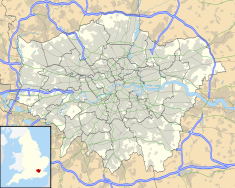Inverforth House
| Inverforth House | |
|---|---|
 |
|
| Location | North End Way, Hampstead, London, NW3 |
| Coordinates | 51°33′53.4″N 0°10′51.44″W / 51.564833°N 0.1809556°WCoordinates: 51°33′53.4″N 0°10′51.44″W / 51.564833°N 0.1809556°W |
| Built | 1895 |
| Architect | Grayson and Ould |
| Architectural style(s) | Queen Anne style |
| Governing body | Privately owned |
|
Listed Building – Grade II
|
|
| Official name: Inverforth House | |
| Designated | 7 September 1988 |
| Reference no. | 1113185 |
Inverforth House (formally known as The Hill) is a large detached house at North End Way on the outskirts of Hampstead in the London Borough of Camden, NW3. Owned by William Lever, 1st Viscount Leverhulme from 1904 to 1925, The Hill was bought by Andrew Weir, 1st Baron Inverforth after Leverhulme's death in 1925, and following was given to Manor House Hospital after Inverforth's death in 1956. Inverforth House was home to the Orthopaedic Society Hospital from the 1950s to the 1980s, and was converted into two houses and seven apartments in the late 1990s.
Rebuilt in the Queen Anne style in 1895 by the architectural firm Grayson and Ould, it is a Grade II listed building. Built from red brick, Inverforth House has a steeply pitched roof. The architectural style of Inverforth House has been described as "Neo-Georgian" with "Queen Anne style wings".
In 2002 English Heritage commemorated Viscount Leverhulme and geneticist and statistician Ronald Fisher, who lived there as a child from 1896 to 1904, with blue plaques.
Inverforth House is situated on North End Way, between Hampstead and Golders Green. The house and gardens adjoin the West Heath, with Golders Hill Park to the north. Sandy Heath and Hampstead Heath are to the south. Inverforth House is close to Heath House, which at 440ft above sea level, was the highest point in the County of London.
From 1896–1904, the house was lived in by the auctioneer and fine arts dealer George Fisher, a partner in Robinson & Fisher and his family of five children, including a young Ronald, the future geneticist and statistician Sir Ronald Fisher. Following his wife's death in 1904, George Fisher lost his fortune within 18 months, and the family moved south of the river to Streatham.
...
Wikipedia

